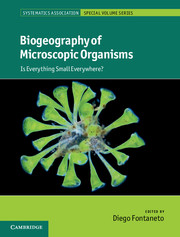Book contents
- Frontmatter
- Contents
- List of contributors
- Preface
- Part I Theoretical framework
- Part II Prokaryotes
- 3 Biogeography of prokaryotes
- 4 Thermophilic bacteria in cool soils: metabolic activity and mechanisms of dispersal
- Part III Unicellular eukaryotes
- Part IV Pluricellular eukaryotes
- Part V Processes
- Index
- Systematics Association Publications
- Systematics Association Special Volumes
- Plate section
- References
4 - Thermophilic bacteria in cool soils: metabolic activity and mechanisms of dispersal
from Part II - Prokaryotes
Published online by Cambridge University Press: 05 August 2012
- Frontmatter
- Contents
- List of contributors
- Preface
- Part I Theoretical framework
- Part II Prokaryotes
- 3 Biogeography of prokaryotes
- 4 Thermophilic bacteria in cool soils: metabolic activity and mechanisms of dispersal
- Part III Unicellular eukaryotes
- Part IV Pluricellular eukaryotes
- Part V Processes
- Index
- Systematics Association Publications
- Systematics Association Special Volumes
- Plate section
- References
Summary
Introduction
The biogeographic patterns of plants and animals, i.e. the distribution of biodiversity over space and time has been studied for many years; however, the question whether microorganisms display similar biogeographic patterns remains unanswered (Fenchel et al., 1997). A fundamental assumption that ‘everything is everywhere, but the environment selects’ was generally promulgated by the Dutch microbiologist Martinus Wilhelm Beijerinck early in the twentieth century and further supported by Baas Becking in 1934. This hypothesis strongly influenced the scientific community throughout the century, leading to widespread acceptance (O'Malley 2008). If the environment is indeed responsible for ‘selecting’ the organisms in a particular habitat, then we should expect to be able to identify the specific controlling factors for particular organisms. As a consequence of this speculation and as suggested by the literature and experience, the presence of thermophilic bacteria is to be expected in hot environments, from which many of these organisms have been indeed isolated. However, the presence of thermophilic bacteria in cooler environments has been known for many years but few investigations have been carried out to assess their physiology, their ecological roles and to interpret their presence in the framework of biogeographic theory. In 2002 Marchant and colleagues initiated the investigation of the occurrence of highly thermophilic bacteria in cool soil environments, isolating five bacterial strains able to grow aerobically only above 40°C, a temperature never achieved in these soils.
- Type
- Chapter
- Information
- Biogeography of Microscopic OrganismsIs Everything Small Everywhere?, pp. 43 - 58Publisher: Cambridge University PressPrint publication year: 2011
References
- 3
- Cited by

